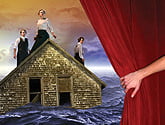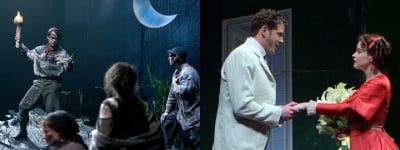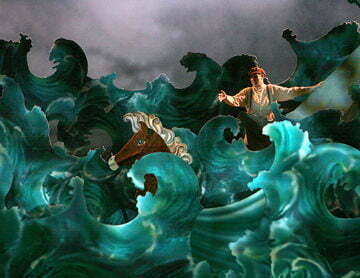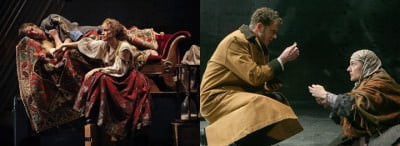A True History of the Johnstown Flood-two reviews

Johnstown Flood
By: Rebecca Gilman
Directed by: Robert Falls
In the Albert Ivar Goodman Theatre
Amazing Design overshadows muddy script in Johnstown Flood.
Natural disasters have always been a common backdrop for dramatic action; consider disaster films such as The Poseidon Adventure, Titanic, or most recently 2012. Sadly, in these scenarios the effects and spectacle often overshadow the acting or story. A True History of the Johnstown Flood unfortunately falls into this category because it feels as though more thought went into perfecting the top-notch set and lighting design rather than honing in on the story.
The play chronicles the journey of the three Baxter siblings: James (Stephen Louis Grush), Richard (Cliff Chamberlain), and Fanny (Heather Wood). The Baxter’s are the second generation of a famous traveling theatre family and have been summoned to perform for the high-end South Fork Fishing and Hunting Club, set on a man-made lake up in the Allegheny Mountains. The troupe performs a repertoire of comic melodrama penned by their late father, but James dreams of writing a new kind of theatre about the struggles of the people. The troupe is in financial trouble which leads Richard and Fanny to fall under the influence of the wealthy Walter (Lucas Hall). As their domestic quarrels spill onto the stage, a violent rainstorm causes the poorly made dam surrounding the lake to collapse. The disaster brings to light the inequality of the class system, and ushers in an era of change in society and theatre. With such an interesting premise with plenty of opportunity for dramatic action, Johnstown never fully engages any of the plotlines or ideas. Each subject is merely touched on rather than fully explored which makes the journey scattershot and incomplete with the final scene feeling insignificant.
The play should consider having a different title because even the playwright, Rebecca Gilman, admits to taking certain liberties and that the play is a work of fiction. I believe the title relates to the play-within-a-play scenes, two of which are in each act. These start off as simple melodrama and evolve into a more honest portrait of real life. These moments are by far the most interesting parts of the production because they are funny, honest, and revealing about the evolution of theatre in America. The problems lie in scenes set in reality. Without giving too much away, it feels as though certain plotlines are left unfinished and scenes start to drag on about facts and social change. It becomes less and less about the characters and more about ideas. I believe that if Gilman had focused solely on how the role of theatre evolved in America and around the world then the production would have been a lot more focused and interesting. Right now the script combines too many types of plays into a single production. All at once it is an over-the-top comedy, disaster epic, melodrama, family drama, history play, and Clifford Odetts play which makes for an unsatisfying and uneven mix.
In terms of acting, the ones who steal the show are Janet Ulrich Brooks and Randall Newsome. These two play several characters differing in status, nationality, and physique convincingly and effortlessly. I especially enjoyed the subtly acidic manner Ms. Books displays as Mrs. Lippincott. The three siblings are a strong trio in the early scenes, and play off each other well in the melodramas, but as the play progresses their relationship gets two-dimensional. I do not necessarily fault the actors for this because the second act feels incomplete and is not as strongly written as the first act. The scenes started to feel more like a shouting match, and the love the siblings showed for one another early on diminishes and nearly disappears. The dramatic moments feel flat, forced, and out of place which gives the actors little to work with. The other reason that it is hard to fault the actors is because the acting is completely overshadowed by the technical aspects of the show.
Director Robert Falls has brought together a top-notch design team, and they are the true stars of this production. Walt Spangler’s sprawling sets; complete with full-train cars, mist, melodrama scenery, and the wreckage of Johnstown are grand in scale and exact in detail. James F. Ingalls’ lighting is tightly choreographed and precise in its color scheme; perfectly creating the right atmosphere at the right moment. Ana Kuzmanic’s costume design is simple when necessary and elegant when needed. The costumes for the melodramas in particular are a fun visual feast. I would also like to make mention of sound designer Richard Woodbury’s deafening sound effect when the dam collapses. This moment fills the theatre with such an avalanche of audio that I felt as though I was experiencing the dam collapsing in my seat. My only disappointment is that this was not the closing moment of the first act. Although the tech is phenomenal, I do not understand why Mr. Falls used large sets in some of the more intimate scenes (most specifically a tender moment between the three siblings towards the end of the play.). In these scenes, the dramatic action felt secondary because my eyes were wandering through the visual landscape.
This production marks the sixth time Robert Falls and Rebecca Gilman have collaborated to create a piece for the Goodman. With such an astounding history of collaboration, it is disappointing that the direction does not seem to fit the script (which is in need of a few more re-writes). In their defense, Mr. Falls did call this production, “…one of Rebecca’s most ambitious works to date,” which implies this is new territory for both of them. Sadly, the ambition of the project is greater than the actual production is able to achieve. It is an interesting backdrop for a play, and the opportunities for dramatic action are numerous, so with a few re-writes and editing Ms. Gilman may be able to express all the ideas she is attempting to convey. Sadly, for the time being the message is drowned out by the incomplete feeling of the script and the visual spectacle.
Not Recommended
Jake Lindquist
At The Albert Ivar Goodman Theatre, 2257 N. Lincoln Ave., Chicago. Tickets $19-$76, Call 312-443-3800, www.goodmantheatre.org. Wednesdays, Thursdays, and Sundays at 7:30 PM. Fridays and Saturdays at 8:00 PM. Thursdays, Saturdays, and Sundays at 2:00 PM (Varies by week, double check listings). Running time is approximately 2 hours and 20 minutes including a 15-minute intermission. Through April 18.
A True History of the Johnstown Flood
Review by Tom Williams
I have been of fan of Rebecca Gilman’s work for sometime and I was looking forward to her latest – A True History of the Johnstown Flood. Despite the fantastic visual spectacle from Walt Spangler’s sets (including both the old-time wing-and-drop sets and the flood scenes), the strong lighting (by James F. Ingalls) and the shattering sound effects (by Richard Woodbury), I found the script underwritten and incomplete. In act one, we meet the Baxter family of actors and we sit through two long play-within-a-play melodramas depicting 19th Century acting style. We also have plot lines about rich capitalists versus poor working classes. Pleasure versus the environment and public safety and the aftermath of relief when a disaster occurs are hinted at but not fully developed in Gilman’s play. Act two is incomplete and ends abruptly without adequate resolutions.
The spectacle and moments in act one are worthy but the overall theatrical experience is quite disappointing. So many questions are left unanswered in act two that I felt pages of the script must have been lost. A re-think of act two could serve this play well. As it plays now, it promises much but delivers little.
Not Recommended





I saw the play recently and liked it very much. I had read bad reviews and also a good one from Time Magazine, but they did not influence my opinion. I grew up in Johnstown, so it was fun to hear names of nearby places like Mineral Point and South Fork on a Chicago theater stage. But again, that was not what made the play enjoyable to me. I feel that I enjoyed the play as much as most that I’ve seen. It was an interesting story and moved along at a good pace. The second act was a little bleak, but is set during a disaster, so that’s to be expected. I would definitely recommend this play.
I’m glad you enjoyed the show.
As a season ticket holder for the Goodman I obviously am open to experimentation in theatre but this play is just a mess. Gilman can’t make up her mind what she wants this play to be about and it shows. The audience is left so puzzled that they aren’t even sure if the play is over. Many, many left before the end. The production values are huge, elaborate sets, sound, costumes, everything very well staged and acted but the poor actors had so little to work with I felt sorry for them. They tried but had little characterization to work with. This is actually the worst play I have ever had the misfortune to sit through. How could the Goodman have put this on? In her obvious concern for the role of actors in society, Gilman trivializes real human tragedy whether the actual Johnstown Flood or Katrina. Well like Brownie, she does a hell of a job! I was actually offended that a very well written history book was used so shabbily by Gilman and Falls. My advice to any potential theatre goers is DON’T. Don’t waste your money or your time on this mess of a play. I sincerely hope that some high minded, foolish producer 20 years from now doesn’t try to “revive” this. It deserves a decent burial.
I agree with your comments. You should let Falls know about you’re unhappiness. Maybe they’ll select better plays in the future.